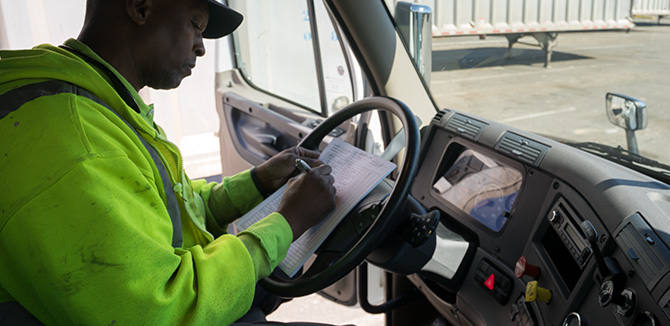How to Survive a Roadside DOT Inspection

Getting pulled over for a roadside DOT inspection can be nerve-wracking. The single biggest key to surviving a roadside DOT inspection is a good attitude. Be cooperative, patient, and positive. Understand that the officer is just doing his job. Own your mistakes and agree to resolve any issues as soon as possible.
Being defensive, argumentative, or combative will only make matters worse and possibly prompt an even longer delay or more rigorous inspection. Just sit tight, endure, and know that every driver eventually gets pulled over.
Here are a few tips to help you or your drivers sail through the next roadside DOT inspection.
1. Always perform a thorough pre-trip standard inspection
Before each trip, go through the checklist on your Driver’s Vehicle Inspection Report (DVIR). If you invest the time before heading out, you’ll catch many of the things that get you pulled over, reducing your chances of being pulled over and saving yourself time down the road.
When training new drivers, I make a point to ask what they think is the minimum amount of time they should spend on a pre-trip standard inspection. It’s a trick question because there isn’t a correct number. Instead, I tell our drivers to go on duty, then perform a thorough inspection, and log the time. Whatever time that takes is how much time it takes. It’s just part of the job.
2. Be prepared for a DOT inspection
Get your paperwork together in a single folder so that it’s always available. Some documents to check and include are:
- Your commercial driver's license (CDL)
- Medical Examiner’s Certificate
- Record of Duty Status – Is it current?
- Vehicle registration card – Is the license plate current and not expired?
- Vehicle insurance documents – Current year expiration date?
- Annual vehicle inspection stickers on tractor and trailer – Are they not expired?
- Any applicable permits, including hazardous materials permits
3. Provide the officer whatever they request
Your job is not to ask why, but to comply. The sooner you deliver, the faster you’ll be back on the road.
4. Ask the officer to point out the violation
Tell the officer you’d like to be able to address the violation properly. Take a picture and document it for repairs, if necessary.
5. Do a truck inspection of your own before getting back on the road after each stop
Anytime you make a stop, things can change. You hit a pothole and your headlights can go out due to a broken filament. Signs pop loose. It’s good to take a quick walk around your truck for a visual inspection after every stop, just to make sure everything’s good to go.
Contact Lytx to learn more about our fleet safety and compliance management solutions.
